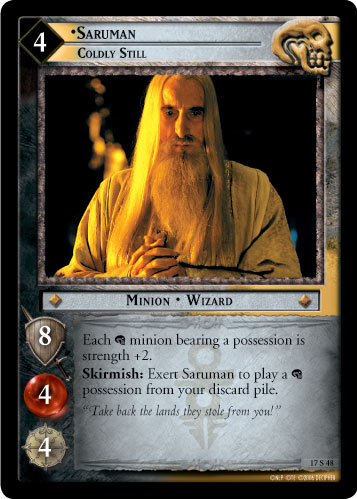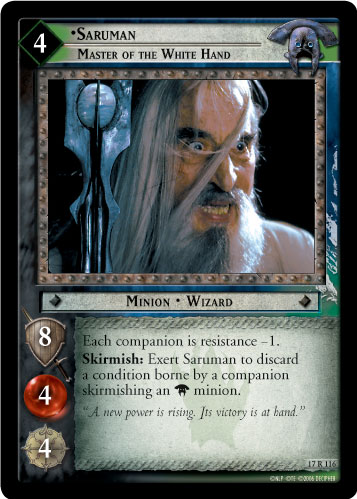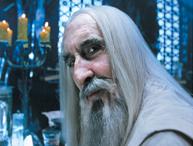Saruman
The corrupted White Wizard Saruman is the chief of the White Council and, secretly, the treacherous servant of Sauron, plotting to betray his former allies and then usurp his master. In this game, he is the only Shadow wizard, and appears as both a minion and a follower. First appearing on his own card in Realms of the Elf-Lords, Saruman leads the Isengard culture, which includes most cards associated with Saruman, including his army of Uruk-hai and orcs, as well as corrupt men like Grima.
Most versions of Saruman, particularly in Fellowship Block and Tower Block, are minions that can't skirmish or soak wounds in the Archery Phase, with high vitality for exertion abilities that buff other minions or interfere with the opponent. Avoiding archery and skirmishes makes it wickedly difficult for the Free Peoples player to stop cards like Saruman, Keeper of Isengard (3R68)
 or Saruman, Rabble-rouser (4R33)
or Saruman, Rabble-rouser (4R33)
 from turning mundane minions into monsters. Options to do so are rare: the most common is non-archery-phase direct wounding, like Betrayal of Isengard (3R29)
from turning mundane minions into monsters. Options to do so are rare: the most common is non-archery-phase direct wounding, like Betrayal of Isengard (3R29)
 . However, this protection is a double-edged sword. Saruman's Twilight cost isn't cheap and he can't do any damage on his own without Saruman's Staff, Wizard's Device (4R174)
. However, this protection is a double-edged sword. Saruman's Twilight cost isn't cheap and he can't do any damage on his own without Saruman's Staff, Wizard's Device (4R174)
 , so he may be stuck in the Shadow player's hand until they have enough other Shadow cards to make him worth it. Later versions of Saruman mostly abandon this mechanic and work more like typical minions, however.
, so he may be stuck in the Shadow player's hand until they have enough other Shadow cards to make him worth it. Later versions of Saruman mostly abandon this mechanic and work more like typical minions, however.
Befitting his self-applied title "of Many Colours," Saruman also appears on cards in other cultures besides Isengard, representing his capacity as leader and instigator. He's the first character in the game to appear in a second culture, with Saruman, Rabble-rouser (4R33)
 . Of all unique characters, Saruman appears in the most different cultures:
. Of all unique characters, Saruman appears in the most different cultures: Isengard,
Dunland,
Men, and
Uruk-hai cultures. (The next closest is Gothmog, who appears in three, followed by Aragorn and many Shadow characters appearing in two.)
Along with Grima, the Balrog, the Watcher in the Water, Many-tentacled Creature (19P21)
 , and Sauron himself, Saruman is one of the few characters who continues to appear in his original culture after the Shadow cultures are reorganized in the Shadows set. Unlike most of those, he appears in both his original culture in the post-Shadows sets as well as in the new post-Shadows cultures, a trait he shares only with his servant Grima. He is also one of only two characters in the game to appear in multiple different cultures in the same set, having done so in three of the five sets he appears in. (The only other character is the Mouth of Sauron, who appears in two separate cultures in Black Rider.) He is also the only Shadow follower in the entire game, as Saruman, Servant of Sauron (17R38)
, and Sauron himself, Saruman is one of the few characters who continues to appear in his original culture after the Shadow cultures are reorganized in the Shadows set. Unlike most of those, he appears in both his original culture in the post-Shadows sets as well as in the new post-Shadows cultures, a trait he shares only with his servant Grima. He is also one of only two characters in the game to appear in multiple different cultures in the same set, having done so in three of the five sets he appears in. (The only other character is the Mouth of Sauron, who appears in two separate cultures in Black Rider.) He is also the only Shadow follower in the entire game, as Saruman, Servant of Sauron (17R38)
 .
.
Versions of Saruman[edit]
| Portrait | Name | Game Text |
|---|---|---|
Saruman, Keeper of Isengard (3R68)

|
Saruman may not take wounds during the archery phase and may not be assigned to a skirmish.
Uruk-hai are fierce. Response: If an Uruk-hai is about to take a wound, exert Saruman to prevent that wound. | |
Saruman, Servant of the Eye (3C69)

|
Saruman may not take wounds during the archery phase and may not be assigned to a skirmish.
Assignment: Exert Saruman to assign an | |
Saruman, Rabble-rouser (4R33)

|
Saruman may not be assigned to a skirmish.
Each time the fellowship moves, the Free Peoples player must exert a companion for each | |
Saruman, Black Traitor (4R173)

|
Saruman may not take wounds during the archery phase and may not be assigned to a skirmish.
When you play Saruman, you may discard a condition. Shadow: Exert Saruman to play Saruman’s Staff from your discard pile. | |
Saruman, Master of Foul Folk (5R56)

|
Saruman may not take wounds during the archery phase and may not be assigned to a skirmish.
Each time the fellowship moves, you may heal each Shadow: Exert Saruman to play an | |
Saruman, Of Many Colours (12R54)

|
Damage +1. Fierce. Lurker. (Skirmishes involving lurker minions must be resolved after any others.) When you play Saruman, name a culture. Each companion of the named culture is strength –1. | |
Saruman, Agent of the Dark Lord (12S144)

|
Lurker. (Skirmishes involving lurker minions must be resolved after any others.)
Skirmish: Exert Saruman to make an Each time a companion is killed, you may heal Saruman. | |
Saruman, Instigator of Insurrection (17R37)

|
Saruman cannot be assigned to a skirmish.
While you can spot 6 companions, each minion gains hunter 2. Response: If a hunter minion is about to take a wound, exert Saruman to prevent that. | |
Saruman, Servant of Sauron (17R38)

|
Aid - Each time bearer wins a skirmish, you may exert a companion. | |
Saruman, Coldly Still (17S48)

|
Each Skirmish: Exert Saruman to play a | |
Saruman, Curunir (17S115)

|
Each time an Skirmish: Exert Saruman twice to make a companion lose the hunter keyword until the start of the regroup phase. | |
Saruman, Master of the White Hand (17R116)

|
Each companion is resistance -1.
Skirmish: Exert Saruman to discard a condition borne by a companion skirmishing an | |
Saruman, Mind of Metal and Wheels (V2_29)

|
Saruman may not be assigned to a skirmish.
Companions skirmishing <symbol>Isengard</symbol> Orcs lose all damage bonuses. Response: If an | |
Saruman, Fell Voice (V1_30)

|
While you cannot spot a weather, Saruman may not take wounds in the archery phase and may not be assigned to a skirmish.
While at a site bearing a weather, each Response: If the fellowship moves from a site bearing a weather, discard this minion to exert each companion. |
Cards that mention Saruman by name[edit]
to-do













